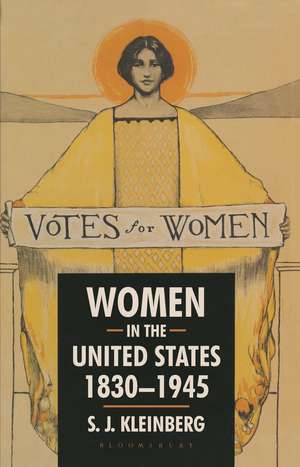Women in the United States, 1830-1945: American History in Depth
Autor S. J. Kleinbergen Limba Engleză Paperback – 22 aug 1999
Preț: 252.58 lei
Nou
48.33€ • 50.46$ • 40.00£
Carte tipărită la comandă
Livrare economică 04-18 aprilie
Specificații
ISBN-10: 0333610989
Pagini: 384
Dimensiuni: 140 x 216 x 20 mm
Greutate: 0.45 kg
Ediția:1999
Editura: Bloomsbury Publishing
Colecția Bloomsbury Academic
Seria American History in Depth
Locul publicării:London, United Kingdom
Caracteristici
Contrasts the lives of women from different ethnic, racial and economic groups to give a full picture of women's everyday existence
Rectifies the omission of women from the American historical record of this period by examining their central roles in issues such as slavery, the industrial revolution and the reform movements
Notă biografică
S.J. KLEINBERG is Professor and Head of the Department of American Studies and History, Brunel University.
Cuprins
Introduction.- PART ONE: ANTE-BELLUM AMERICA.- Economic Activity in Ante-Bellum America.- Family and Migration in the Era of Domesticity.- Education and Culture in Ante-Bellum America.- Religion, Reform and Politics in the Ante-Bellum Era.- PART TWO: THE INDUSTRIAL ERA.- Women's Employment 1865-1920.- Family and Migration in the Industrial Era.- Education and Culture 1865-1920.- Women and Reform in the Gilded Age and Progressive Era.- PART THREE: BOOM, BUST AND WAR.- Economic Activity during Boom, Bust and War.- Family and Migration 1920-1945.- Education and Culture 1920-1945.- Reform and Politics 1920-1945.- Bibliography.- Index.
Descriere
Women in the United States, 1830-1945 investigates women's economic, social, political and cultural history, encompassing all ethnic and racial groups and religions. It provides a general introduction to the history of women in industrializing America. Both a history of women and a history of the United States, its chronology is shaped by economic stages and political events. Although there were vast changes in all aspects of women's lives, gender (the social roles imputed to the sexes) continued to define women's (and men's) lives as much in 1945 as it had in 1830.
























